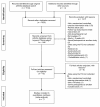Exercise and global well-being in community-dwelling adults with fibromyalgia: a systematic review with meta-analysis
- PMID: 20406476
- PMCID: PMC2874776
- DOI: 10.1186/1471-2458-10-198
Exercise and global well-being in community-dwelling adults with fibromyalgia: a systematic review with meta-analysis
Abstract
Background: Exercise has been recommended for improving global-well being in adults with fibromyalgia. However, no meta-analysis has determined the effects of exercise on global well-being using a single instrument and when analyzed separately according to intention-to-treat and per-protocol analyses. The purpose of this study was to fill that gap.
Methods: Studies were derived from six electronic sources, cross-referencing from retrieved studies and expert review. Dual selection of randomized controlled exercise training studies published between January 1, 1980 and January 1, 2008 and in which global well-being was assessed using the Fibromyalgia Impact Questionnaire (FIQ) were included. Dual abstraction of data for study, subject and exercise program characteristics as well as assessment of changes in global well-being using the total score from the FIQ was conducted. Risk of bias was assessed using the Cochrane bias assessment tool. Random-effects models and Hedge's standardized effect size (g) were used to pool results according to per-protocol and intention-to-treat analyses.
Results: Of 1,025 studies screened, 7 representing 5 per-protocol and 5 intention-to-treat outcomes in 473 (280 exercise, 193 control) primarily female (99%) participants 18-73 years of age were included. Small, statistically significant improvements in global well-being were observed for per-protocol (g and 95% confidence interval, -0.39, -0.69 to -0.08) and intention-to-treat (-0.34, -0.53 to -0.14) analyses. No statistically significant within-group heterogeneity was found (per-protocol, Qw = 6.04, p = 0.20, I2 = 33.8%; intention-to-treat, Qw = 3.19, p = 0.53, I2 = 0%) and no between-group differences for per-protocol and intention-to-treat outcomes were observed (Qb = 0.07, p = 0.80). Changes were equivalent to improvements of 8.2% for per-protocol analyses and 7.3% for intention-to-treat analyses.
Conclusions: The results of this study suggest that exercise improves global well-being in community-dwelling women with fibromyalgia. However, additional research on this topic is needed, including research in men as well as optimal exercise programs for improving global well-being in adults.
Figures




Similar articles
-
Transcutaneous electrical nerve stimulation (TENS) for fibromyalgia in adults.Cochrane Database Syst Rev. 2017 Oct 9;10(10):CD012172. doi: 10.1002/14651858.CD012172.pub2. Cochrane Database Syst Rev. 2017. PMID: 28990665 Free PMC article.
-
Home treatment for mental health problems: a systematic review.Health Technol Assess. 2001;5(15):1-139. doi: 10.3310/hta5150. Health Technol Assess. 2001. PMID: 11532236
-
Whole body vibration exercise training for fibromyalgia.Cochrane Database Syst Rev. 2017 Sep 26;9(9):CD011755. doi: 10.1002/14651858.CD011755.pub2. Cochrane Database Syst Rev. 2017. PMID: 28950401 Free PMC article.
-
Systemic pharmacological treatments for chronic plaque psoriasis: a network meta-analysis.Cochrane Database Syst Rev. 2021 Apr 19;4(4):CD011535. doi: 10.1002/14651858.CD011535.pub4. Cochrane Database Syst Rev. 2021. Update in: Cochrane Database Syst Rev. 2022 May 23;5:CD011535. doi: 10.1002/14651858.CD011535.pub5. PMID: 33871055 Free PMC article. Updated.
-
Physical exercise training interventions for children and young adults during and after treatment for childhood cancer.Cochrane Database Syst Rev. 2016 Mar 31;3(3):CD008796. doi: 10.1002/14651858.CD008796.pub3. Cochrane Database Syst Rev. 2016. PMID: 27030386 Free PMC article.
Cited by
-
Exercise therapy for fibromyalgia.Curr Pain Headache Rep. 2011 Oct;15(5):358-67. doi: 10.1007/s11916-011-0214-2. Curr Pain Headache Rep. 2011. PMID: 21725900 Free PMC article. Review.
-
Targeting pain catastrophization in patients with fibromyalgia using virtual reality exposure therapy: a proof-of-concept study.J Phys Ther Sci. 2015 Nov;27(11):3461-7. doi: 10.1589/jpts.27.3461. Epub 2015 Nov 30. J Phys Ther Sci. 2015. PMID: 26696719 Free PMC article.
-
Efficacy of supervised exercise combined with transcutaneous electrical nerve stimulation in women with fibromyalgia: a prospective controlled study.Rheumatol Int. 2013 Mar;33(3):649-55. doi: 10.1007/s00296-012-2390-8. Epub 2012 Apr 11. Rheumatol Int. 2013. PMID: 22527135 Clinical Trial.
-
The Efficiency of Kinesiotherapy versus Physical Modalities on Pain and Other Common Complaints in Fibromyalgia.Life (Basel). 2024 May 8;14(5):604. doi: 10.3390/life14050604. Life (Basel). 2024. PMID: 38792625 Free PMC article.
-
Physical exercise as non-pharmacological treatment of chronic pain: Why and when.Best Pract Res Clin Rheumatol. 2015 Feb;29(1):120-30. doi: 10.1016/j.berh.2015.04.022. Epub 2015 May 23. Best Pract Res Clin Rheumatol. 2015. PMID: 26267006 Free PMC article. Review.
References
-
- Questions and answers about fibromyalgia. http://www.niams.nih.gov/Health_Info/Fibromyalgia/default.asp - PubMed
Publication types
MeSH terms
Grants and funding
LinkOut - more resources
Full Text Sources
Medical
Miscellaneous

